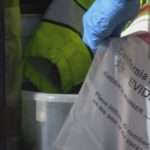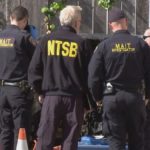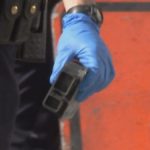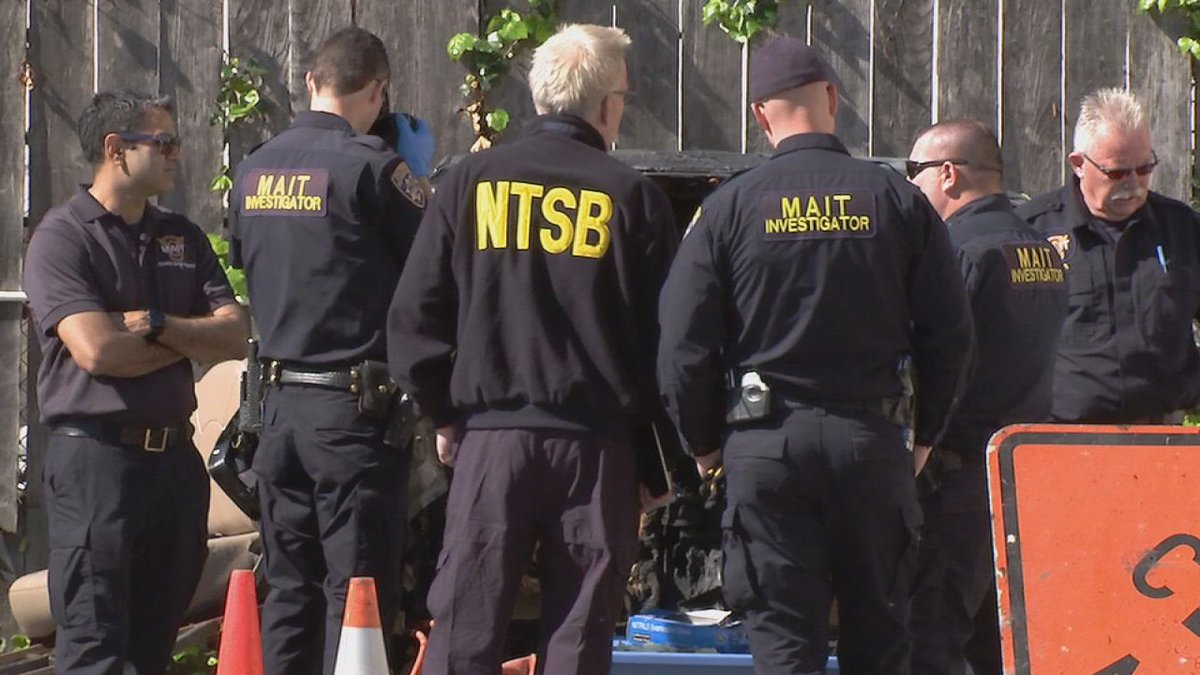
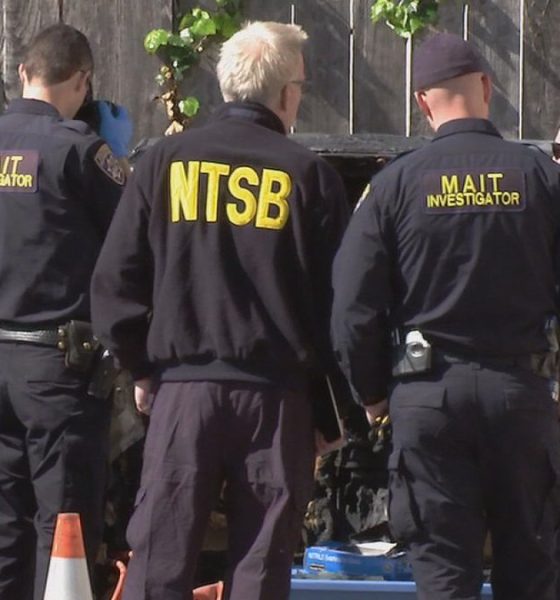
News
Tesla modules retrieved by NTSB could reveal clues on fatal Model X crash
NTSB investigators looking into the fatal Tesla Model X crash have retrieved the ill-fated SUV’s restraint control module and infotainment module from the wreckage of the vehicle.
Photographs of the ongoing NTSB investigation have been shared online by ABC7 News photographer Dean C. Smith. The series of pictures depicts a team of investigators from both the NTSB and the CHP’s Multidisciplinary Accident Investigation Team inspecting the wrecked Tesla. Smith was also able to photograph a module from the electric SUV being placed inside an evidence bag.
The NTSB later confirmed to the local news agency that the investigators were able to recover two components of the destroyed Model X — the vehicle’s restraint control module and its infotainment module. NTSB Spokesman Christopher O’Neil noted that the NTSB would be working with Tesla and the CHP in analyzing the data stored in the two devices.
“We’re going to work with CHP and Tesla to download the information from those modules and then see what data is available to us that might give insights into what was going on during the accident sequence,” O’Neil said.
Images of the continuing investigation from the NTSB and CHP could be viewed below.
- The NTSB’s investigation into a fatal Tesla Model X crash continues. [Credit: Dean C. Smith/Twitter]
- The NTSB’s investigation into a fatal Tesla Model X crash continues. [Credit: Dean C. Smith/Twitter]
- The NTSB’s investigation into a fatal Tesla Model X crash continues. [Credit: Dean C. Smith/Twitter]
- The NTSB’s investigation into a fatal Tesla Model X crash continues. [Credit: Dean C. Smith/Twitter]
Will Huang, the brother of the ill-fated electric SUV’s driver, has also shared some of his insights about the crash in a statement to ABC7. According to Will, his brother had brought the car to the Tesla service center before the accident due to what he believes were issues with the Model X’s Autopilot. Tesla has noted, however, that the owner of the Model X had taken the vehicle to the service center because of concerns about the SUV’s navigation, not its Autopilot, according to the local news agency.
“We’ve been doing a thorough search of our service records, and we cannot find anything suggesting that the customer ever complained to Tesla about the performance of Autopilot. There was a concern raised once about navigation not working correctly, but Autopilot’s performance is unrelated to navigation,” Tesla reportedly stated.
In a statement to the local news agency, Will Huang noted that a crash attenuator could have likely saved his brother’s life. Crash attenuators, better known as crash cushions, are designed to absorb the impact of a vehicle’s collision. As noted by Tesla in its blog post yesterday, however, a huge part of the crash cushion on the spot where the Model X met its end had been removed due to a previous collision.

“That (the crash attenuator) ultimately should’ve saved my brother’s life. We’ve seen videos of similar crash(es) with cushion, and the driver walked out of it unharmed,” Huang noted.
In a recent announcement on its Twitter account, CHP Redwood City revealed that the last collision recorded at the same location as the ill-fated Model X crash happened on March 12, 2018, 11 days before the Tesla’s accident.
Update on #Tesla collision: Per media request, the last collision recorded at that same location took place on Monday 3/12/2018 at 2230 hours. pic.twitter.com/ibizNYWOkk
— CHP Redwood City (@CHP_RedwoodCity) March 29, 2018
The Tesla Model X has a 5-star safety rating from the National Highway Traffic Safety Administration (NHTSA). The electric SUV is equipped with 12 airbags — head and knee airbags in the front, 2 side curtain airbags, 4 seat-mounted side airbags, and 2 door-mounted airbags — which cocoon a driver and the vehicle’s passengers during an accident. As we reported last December, a Model X successfully protected its driver after getting into an accident with a car traveling at near-highway speeds. During that incident, all the Model X’s airbags deployed, and the driver was able to walk away from the collision unharmed.

Elon Musk
Elon Musk and Tesla AI Director share insights after empty driver seat Robotaxi rides
The executives’ unoccupied tests hint at the rapid progress of Tesla’s unsupervised Robotaxi efforts.

Tesla CEO Elon Musk and AI Director Ashok Elluswamy celebrated Christmas Eve by sharing personal experiences with Robotaxi vehicles that had no safety monitor or occupant in the driver’s seat. Musk described the system’s “perfect driving” around Austin, while Elluswamy posted video from the back seat, calling it “an amazing experience.”
The executives’ unoccupied tests hint at the rapid progress of Tesla’s unsupervised Robotaxi efforts.
Elon and Ashok’s firsthand Robotaxi insights
Prior to Musk and the Tesla AI Director’s posts, sightings of unmanned Teslas navigating public roads were widely shared on social media. One such vehicle was spotted in Austin, Texas, which Elon Musk acknowleged by stating that “Testing is underway with no occupants in the car.”
Based on his Christmas Eve post, Musk seemed to have tested an unmanned Tesla himself. “A Tesla with no safety monitor in the car and me sitting in the passenger seat took me all around Austin on Sunday with perfect driving,” Musk wrote in his post.
Elluswamy responded with a 2-minute video showing himself in the rear of an unmanned Tesla. The video featured the vehicle’s empty front seats, as well as its smooth handling through real-world traffic. He captioned his video with the words, “It’s an amazing experience!”
Towards Unsupervised operations
During an xAI Hackathon earlier this month, Elon Musk mentioned that Tesla owed be removing Safety Monitors from its Robotaxis in Austin in just three weeks. “Unsupervised is pretty much solved at this point. So there will be Tesla Robotaxis operating in Austin with no one in them. Not even anyone in the passenger seat in about three weeks,” he said. Musk echoed similar estimates at the 2025 Annual Shareholder Meeting and the Q3 2025 earnings call.
Considering the insights that were posted Musk and Elluswamy, it does appear that Tesla is working hard towards operating its Robotaxis with no safety monitors. This is quite impressive considering that the service was launched just earlier this year.
Elon Musk
Starlink passes 9 million active customers just weeks after hitting 8 million
The milestone highlights the accelerating growth of Starlink, which has now been adding over 20,000 new users per day.

SpaceX’s Starlink satellite internet service has continued its rapid global expansion, surpassing 9 million active customers just weeks after crossing the 8 million mark.
The milestone highlights the accelerating growth of Starlink, which has now been adding over 20,000 new users per day.
9 million customers
In a post on X, SpaceX stated that Starlink now serves over 9 million active users across 155 countries, territories, and markets. The company reached 8 million customers in early November, meaning it added roughly 1 million subscribers in under seven weeks, or about 21,275 new users on average per day.
“Starlink is connecting more than 9M active customers with high-speed internet across 155 countries, territories, and many other markets,” Starlink wrote in a post on its official X account. SpaceX President Gwynne Shotwell also celebrated the milestone on X. “A huge thank you to all of our customers and congrats to the Starlink team for such an incredible product,” she wrote.
That growth rate reflects both rising demand for broadband in underserved regions and Starlink’s expanding satellite constellation, which now includes more than 9,000 low-Earth-orbit satellites designed to deliver high-speed, low-latency internet worldwide.
Starlink’s momentum
Starlink’s momentum has been building up. SpaceX reported 4.6 million Starlink customers in December 2024, followed by 7 million by August 2025, and 8 million customers in November. Independent data also suggests Starlink usage is rising sharply, with Cloudflare reporting that global web traffic from Starlink users more than doubled in 2025, as noted in an Insider report.
Starlink’s momentum is increasingly tied to SpaceX’s broader financial outlook. Elon Musk has said the satellite network is “by far” the company’s largest revenue driver, and reports suggest SpaceX may be positioning itself for an initial public offering as soon as next year, with valuations estimated as high as $1.5 trillion. Musk has also suggested in the past that Starlink could have its own IPO in the future.
News
NVIDIA Director of Robotics: Tesla FSD v14 is the first AI to pass the “Physical Turing Test”
After testing FSD v14, Fan stated that his experience with FSD felt magical at first, but it soon started to feel like a routine.

NVIDIA Director of Robotics Jim Fan has praised Tesla’s Full Self-Driving (Supervised) v14 as the first AI to pass what he described as a “Physical Turing Test.”
After testing FSD v14, Fan stated that his experience with FSD felt magical at first, but it soon started to feel like a routine. And just like smartphones today, removing it now would “actively hurt.”
Jim Fan’s hands-on FSD v14 impressions
Fan, a leading researcher in embodied AI who is currently solving Physical AI at NVIDIA and spearheading the company’s Project GR00T initiative, noted that he actually was late to the Tesla game. He was, however, one of the first to try out FSD v14.
“I was very late to own a Tesla but among the earliest to try out FSD v14. It’s perhaps the first time I experience an AI that passes the Physical Turing Test: after a long day at work, you press a button, lay back, and couldn’t tell if a neural net or a human drove you home,” Fan wrote in a post on X.
Fan added: “Despite knowing exactly how robot learning works, I still find it magical watching the steering wheel turn by itself. First it feels surreal, next it becomes routine. Then, like the smartphone, taking it away actively hurts. This is how humanity gets rewired and glued to god-like technologies.”
The Physical Turing Test
The original Turing Test was conceived by Alan Turing in 1950, and it was aimed at determining if a machine could exhibit behavior that is equivalent to or indistinguishable from a human. By focusing on text-based conversations, the original Turing Test set a high bar for natural language processing and machine learning.
This test has been passed by today’s large language models. However, the capability to converse in a humanlike manner is a completely different challenge from performing real-world problem-solving or physical interactions. Thus, Fan introduced the Physical Turing Test, which challenges AI systems to demonstrate intelligence through physical actions.
Based on Fan’s comments, Tesla has demonstrated these intelligent physical actions with FSD v14. Elon Musk agreed with the NVIDIA executive, stating in a post on X that with FSD v14, “you can sense the sentience maturing.” Musk also praised Tesla AI, calling it the best “real-world AI” today.
